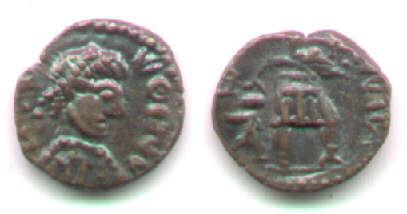
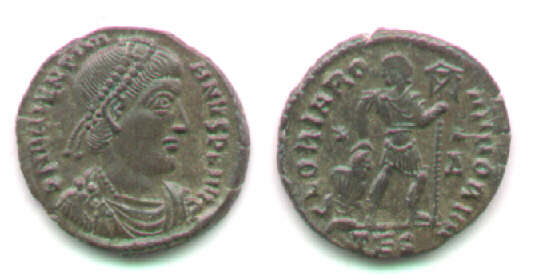
Imitation, uncertain emperor, AE3 and its prototype
Imitations of Late Roman coins from the
period of Valentinian I and later (AD 364 and later)
AE coinage had a small, but significant, percentage of silver until the time of Valentinian I. Counterfeits without any silver would have had significantly less intrinsic value, leaving room for profit. However, with the first issues of Valentinian I, copper coinage did not have intentionally added silver. The copper had as little silver as refining techniques of the time would allow. Therefore, making a full-size imitation in copper would not allow much profit for the counterfeiter. I deduce that these imitations were produced primarily to provide small change in regions where official money was in short supply.
Imitations from this period are rare. The only region from which they seem to be commonly available is Spain, which did not have a mint and which apparently did not receive much official coinage.
In this period there were usually two or more rulers ruling simultantously and issuing the same coin types. On imitations, the reverse type is clear but the ruler is often not (for example, see the first image below). Therefore, the imitations on this page are grouped by type, rather than by ruler.
1) "Galley" GLORIA ROMANORVM
2) REPARATIO REIPVB, emperor raising kneeling female
3) other types (new, Feb. 2018: Valentinian AE1)
4) Vota types
Two coins on this page are imitations overstruck on previous official coins, which is strong evidence that in the fourth century coins were sometimes demonetized.
GLORIA ROMANORVM,
emperor right drags captive and holds labarum.
Valentinian I (364-375)


Imitation, uncertain emperor, AE3 and its prototype
This reverse type was struck for Valentinian I, Valens, Gratian, Valentinian II, Theodosius, and Arcadius.
Imitation: AE14. 2:30. 1.83 grams.
Bold design, a few illegible letter-like forms.
The legend does not attempt a close imitation of an original legend.
/The basic type "emperor right drags captive and holds labarum" is clearly engraved.
/There is a beader rim where the mintmark should be.
Sear 4102 prototype.
Found in Spain in company with an imitation with a clear ASIS mintmark. Bought in Seville. Went to CNG. Bought from them.
CNG list XVIII.2 "1993, Second Quarter" lot 272.
Prototype here: RIC Thessalonica 26, mintmark xvii on pages 169, 178. AE18. 6:00.
"Galley" GLORIA ROMANORVM type
(of 378 - 393, prototypes struck for Gratian, Valentinian II, and Theodosius)
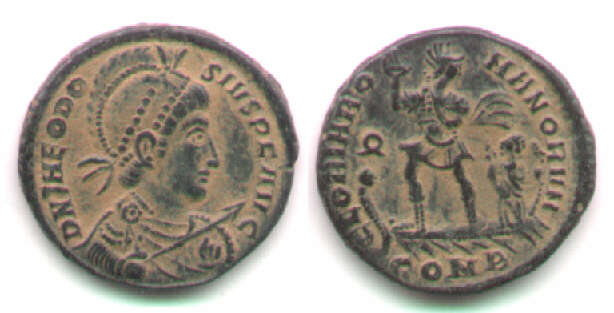 Official Theodosius I (379 - 395)
Official Theodosius I (379 - 395)
AE22, 5:30.
DN THEODO-SIVS PF AVG
Helmeted bust right, emp. holds spear forward in right and shield in left
/GLORIA RO-MANORVM, Emperor standing left, head right, raising right hand, on galley with Victory at the helm
/CONB in exergue, wreath in field left
This example: RIC Constantinople 52c4 "common", struck 379-383
Theodosius I
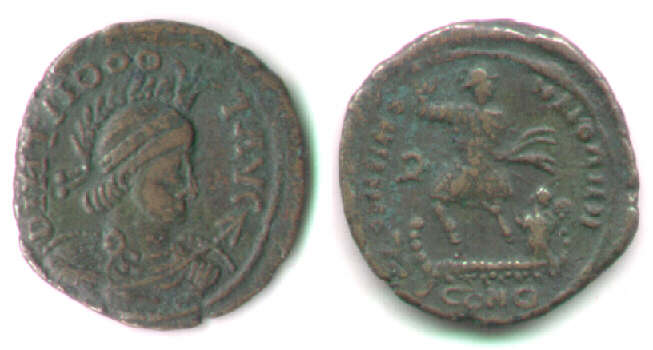 Imitation. AE 25 (large), 1:00. 6.31 grams.
Imitation. AE 25 (large), 1:00. 6.31 grams.
Somewhat irregular style, but reverse design very close to official.
The lettering is crude, vaguely resembling: D I H T H O O O T A V G
/the offical "GLORIA ROMANORVM" was attempted
/mintmark in exergue: CONO (perhaps from a CONE prototype)
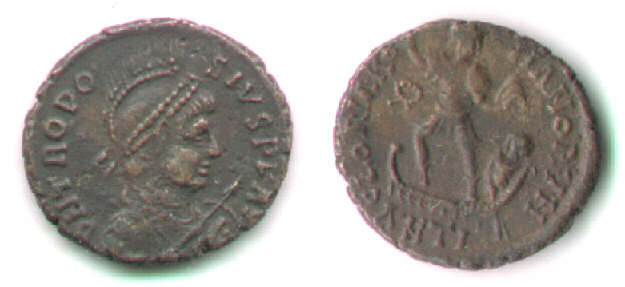 AE21-20. 6:00. 4.84 grams
AE21-20. 6:00. 4.84 grams
Official style, but two features condemn it as an imitation: The obverse legend is misspelled and the reverse officina number "I" did not exist.
DN TRODO-SIVS PF AV[G], Helmeted (with pearl-diadem) draped, cuirassed, bust right holding spear forward and shield
/GLORIA RO-MANORVM (in only slighlty irregular lettering), emperor standing on galley, victory at helm, wreath in field left, ANTI [sic, it is not a gamma]
Prototype Sear 4182. RIC IX Ant 40d, but officina numbers only go up to E (5). Prototype of 378-383.
The seller told me it was "found in Turkey."
Valentinian II (375 - 392)
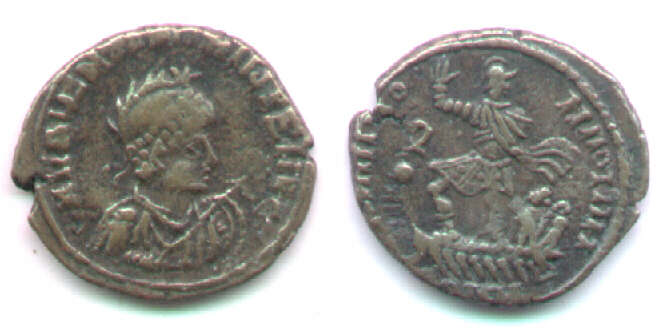 AE24-22. 6:00.
AE24-22. 6:00.
Design of good style. Crude lettering.
Obverse lettering suggests: DN VALENTINIANVS IVN PF AVG
which is found, for example, on RIC Nicomedia 25b.
/the offical "GLORIA ROMANORVM" was attempted
/ mintmark is almost off the flan, but close inspection shows tops that could fit "SMNA"
Gratian (367-383)
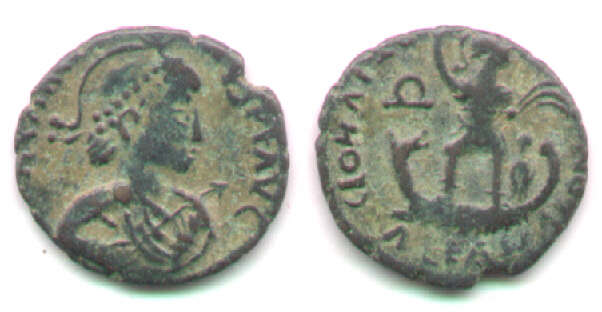 AE22. 6:00.
AE22. 6:00.
Cruder style than the two above.
Much of the left side of the obverse legend is off the flan, but it fits
[DN GRATIA] NVS PG AVG
/crude attempt at GLORIA [rest off the flan]
/Victory at helm is barely outlined, wreath in field left is bold
/in exergue: ALE<delta>
/the mintmark has perhaps the clearest letters
Prototype: RIC Gratian Alexandria 6a, "common"
REPARATIO REIPVB,
emperor raising kneeling female with right and holding Victory on globe in left
(Type of 378 - 388. Prototypes struck for Gratian, Valentinian II, Theodosius, and Magnus Maximus)
Valentinian II (375 - 392)
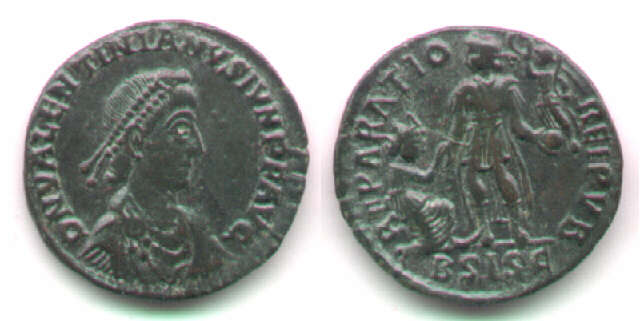 Official Valentinian II
Official Valentinian II
AE23. 12:00. 4.25 grams.
DN VALENTINIANVS IVN PF AVG
/REPARATIO REIPVB, emperor rasing kneeling female. Emperor holds Victory on globe in his left hand.
/BSISC mintmark in exergue
Prototype shown: RIC Siscia 26b2 "common" struck 378-383.
Gratian (367-383)
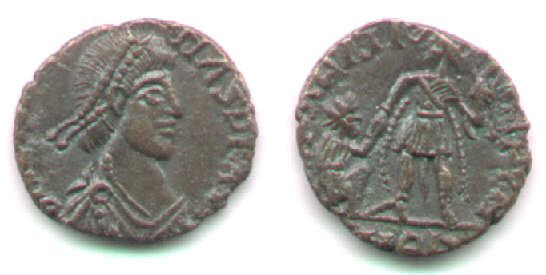 Imitation. AE19. 5:30. 3.41 grams
Imitation. AE19. 5:30. 3.41 grams
Bold, well-struck, and very good style, but for the crude letters.
Obverse elgend resembles: D[......] NASDFAVG
/Reverse legend does attempt " REPARATIO REIPVB" but with crude letters
/minmark in exergue mostly off the flan -- uncertain
Sear 4139 prototype.
FMRZ Lux II, plate VIII.2976 is a similar imitation, but not nearly as well struck.
 Imitation. AE23-21. 4.07 grams
Imitation. AE23-21. 4.07 grams
Imitation from Spain with rather good lettering.
DN GRATIA-NVS P AVG in somewhat irregular letters (note: not "PF" but "P", in error)
diademed, draped, bust right with heavy features
/REPAVTIO - REIYVB [or some such]
/emperor raising kneeling female
/in exergue: LVGP in crude letters, imitating the Lyon mint signature
Prototype: RIC Lyons 28a, page 48, "common".
Valentinian II (375-392)
img style="border: 0px solid ; width: 600px; height: 311px;" src="0093.jpg" alt="Valentinian II imitation" align="middle"> AE23-20. 6:00. 2.66 grams
Obverse has crude letters,some reversed, suggesting ...ALEN-TINIANVS
Reverse has cruder letters.
Prototype: /RESTITVTOR REIPVB
Protype mintmark: SCON (for Constantina = Arelate = modern Arles)
From a dealer in Spain.
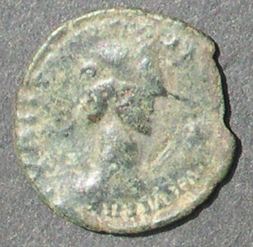

19 mm. Axis of overtype, 11:00. 2.22 grams.
This AE2 type is on a flan much too small and thin.
The flan is from an official AE3
SECVRITAS REPVBLICAE (type 6)
with legend visible at 11:00 - 1:00 and
4:00 - 6:00 on the obverse in this photo.
The axis of the reverse of the undertype is about 2:00
on the obverse photo, but essentially nothing of the Victory type can be seen.
The overtype has legend which appears to begin
with a widely spaced VA
in the normal 7:30 position, suggesting VALENTINIAN (II).
The new reverse has obliterated the type and legend of the overstuck coin.
This is a very crude imitation found in Serbia. How can such an obvious imitation have been worth making? Perhaps the earlier AE3 type was demonetized when it was replaced with the AE2 and AE4 types. The counterfeiter thought it would be better to try to make a new AE2 rather than waste the AE3 flan. [This is mere speculation.]
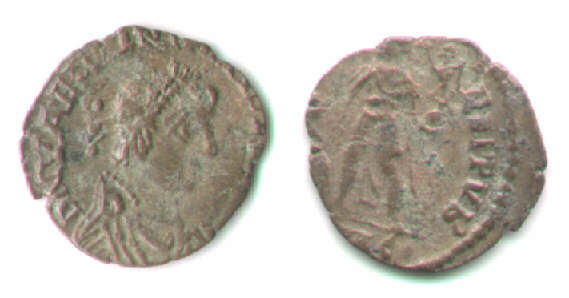 AE19. 12:00. Thin. Smaller than official pieces.
AE19. 12:00. Thin. Smaller than official pieces.
Obverse legend begins well: DN VAL[ ]IN
but continues off the flan
/The flan is too small for the reverse die, so the kneeling female is almost entirely off the flan
/the right side of the reverse legend is visible: REIPVB
/something is in exergue, but it is illegible, possibly ending in "C"
Sear 4162 prototype.
Theodosius I (379-395)
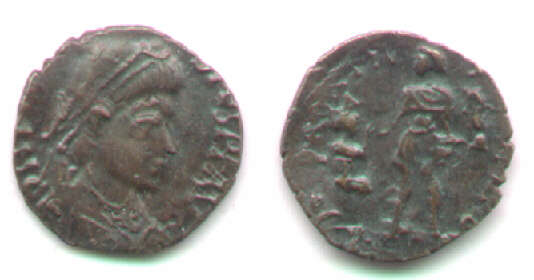 AE18. 11:00. Small flan for type.
AE18. 11:00. Small flan for type.
Obverse legend has recognizable letters: DN [.....]SIVS PF AVG
/reverse legend illegible -- largely off the flan. Only the design is clear.
/the exergue is illegible
Sear 4183 prototype.
 AE19. 7:30. 2.52 grams.
AE19. 7:30. 2.52 grams.
Some parts bold, others flat.
Obverse legend mostly legible: [DN T] HEODO - SV PF AVG is somewhat crude letters
/[RE] PARTIO [letter-like forms]
/no mintmark -- exergue off the flan
Sear 4183 prototype.
Next are two REPARATO REIPVB imitations overstruck on demonetized official coins.
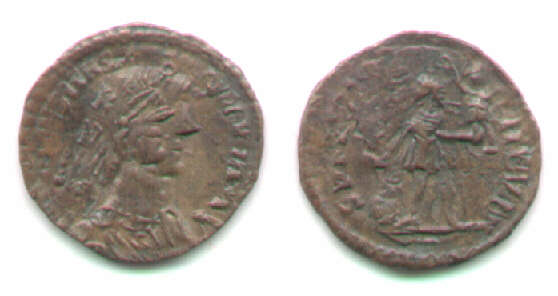
Double struck and overstruck imitation
Valentinian II (?)
AE19. 6:00.
A remarkable coin that suggests that official coinage was officially demonetised and reused as flans for counterfeits!
The imitation is of the REPARATIO REIPVB type very crudely done on a small flan from an offical AE3.
The imitation has a crude head right with garbled legend/emperor raising kneeling female (the female is weakly engraved) holding Victory on globe in his left hand (This is bold).
The undertype is fortunately identifable because just enough of the key parts of the undertype remains.
Behind the head is "RITAS" and a K is on the backof the head, with a V below the K.
On the imitation's reverse (upside down, since the die axis of the undertype was 12:00), hair, eye, and nose are visible, along with "-SPF". These details are enough to recognize the "SECVRITAS REIPVBLICAE" AE3 type of Valens, RIC Siscia 15b, struck 367-375.
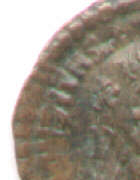

This brings up the question, "Why overstrike an official coin with an imitation?"
It must be that AE3's were demonitized and replaced by AE2's (of the REPARATIO REIPVB type discussed here) and AE4's. This imitation is a crude attempt to turn an AE3 into the new AE2 type.
On the next piece the intended emperor is unclear because the legend was not struck up.

Uncertain emperor
AE25. 6:00. 6.27 grams. Larger than the official coins!
This is an interesting coin. It is an imitation REPARATIO REIPVB type very weakly overstruck on a reduced follis undertype. The original coin was of Maximinus II as Caesar, RIC VI Trier 719a, struck "summer 307." Most of the obverse legend is still clear.
GAL VAL MAXIMINVS NOB [CAES]
/[GENIO POP] ROM
/mintmark PTR in exerge.
Presumably the coins struck prior to the new AE2 REPARATIO REIPVB type were demonetized, making it worthwwhile to recoin them into the new type, even if only as a crude imitation.
Other types
AE1: RESTITVTO[R] - [RE]IPVBLICAE
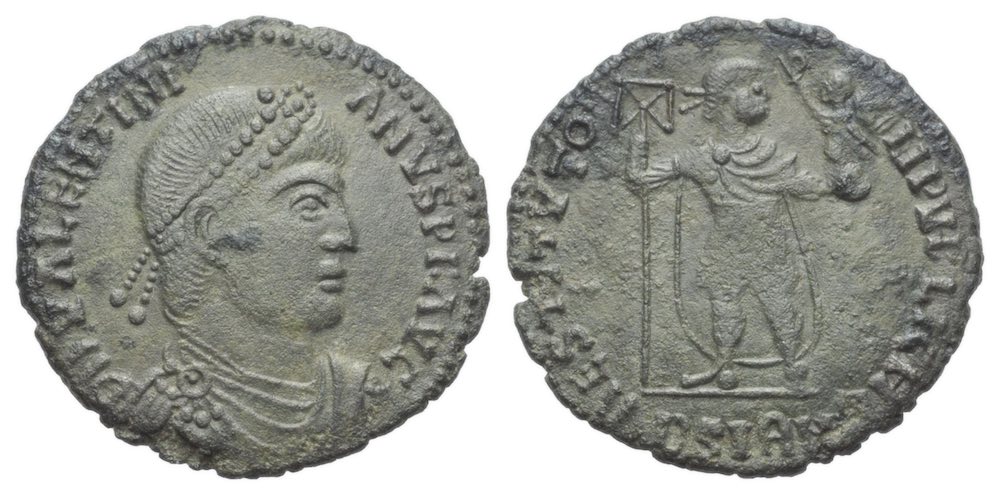
Valentinian, 364-375.
AE1. Large 28 mm and 10.36 grams.
DN VALENTINI-ANVS PF AVG
RESTITVTO[R] - [RE]IPVBLICAE
Emperor standing, head right, holding standard and Victory on globe
BSIRM
Prototype: RIC IX Sirmium 3 "R3" "25 Feb. 364 - end 364" (i.e. From the beginning of the reign until the mint closed.)
If it were an original Valentinian AE1 it would be very rare and desirable. However, its slightly crude lettering and style show it is an imitation. Oddly, it is a tiny bit larger in diameter and 2 grams heavier than most originals, which makes it quite impressive in hand.
GLORIA ROMANORVM AE2
Emperor standing facing, head right, holding standard and globe.
Honorius (393-423)

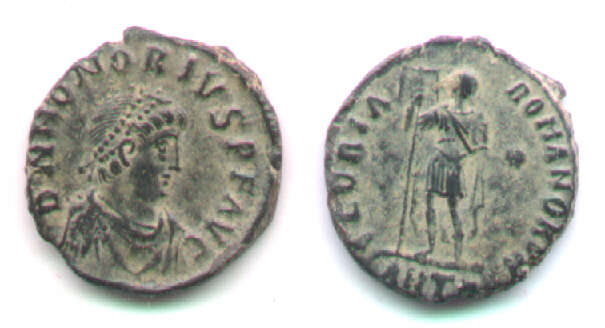
Imitation Honorius AE2. Full size flan. and its prototype
Weak strike. AE22. 11:30. 3.45 grams
Letters suggesting Honorius legend
/letters close to GLORIA ROMANORVM
/attempt at a mintmark SMNA(?)
From a dealer in Spain.
Prototype here: RIC Antioch 68e2, struck 393-395. AE21. 11:30.
Theodosius II (402-450)
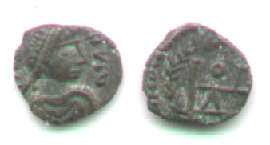 AE8 (tiny!). 5:30. 0.48 grams.
AE8 (tiny!). 5:30. 0.48 grams.
Sharply struck.
/The reverse "monogram in wreath" is not far from the official monogram of Theodosius II, but the left bar is not crossed on top to make it a "T" as it should be.
Many late AE4's are crude and poorly struck. Many 5th century coins accepted without comment as official in the trade may well be ancient imitations. Hoards often have many very poorly made pieces and it is difficult to say if they are official. I will not, at this time, try to draw the line between official and imitation, except to say that coins as small as the one above must be imitations.
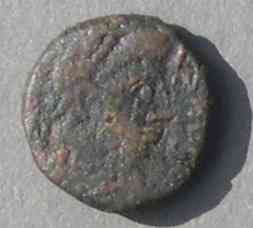
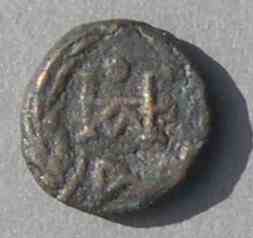
Theodosius II, 402-450 AD. (?)
AE10. 1.14 grams. 7:00.
Prototype RIC X 463, page 277, struck 445-450 according to RIC.
Diademed bust right/monogram in wreath.
This looks a lot like a monogram of Theodosisus II, with many significant differences. Maybe it is of someone else.
The regular monogram of Theodosius II has the left vertical line a clear T with the top crossed. Alson, below the main corssbar the regular issue is a clear delta, whereas this one is a clear A.
The regular issue has a line across the bottom and this one does not.
Kern showed it at the BM and got "barbaric copy?" as a guess.
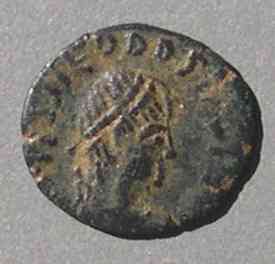
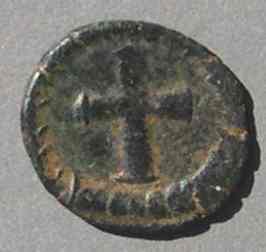
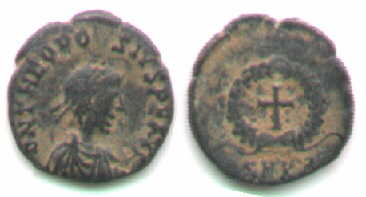
An ancient imitation of this type, with an official issue to the right.
The cross on the imitation is far bolder than normal, and the wreath of greater diameter.
The obverse lettering is good, but crude as these usually are, this one is even cruder.
The mint mark, if any, is off the flan.
AE12-11. 5:30. 0.59 grams.
RIC X 440445, page 275, plate 18, all with more delicate crosses.
The official issue is AE13, 12:00, 1.09 grams, RIC X 449 from Cyzicus, struck 425-435 AD.
Valentinian II (375-392)
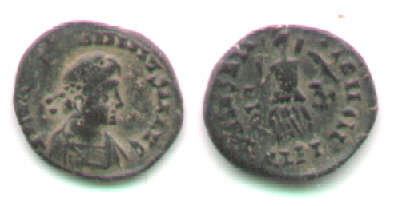
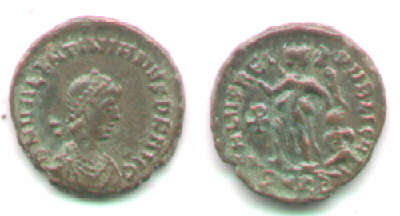
Imitation: AE14-13. 5:00. 1.17 grams. Its prototype: AE14, 12:00. 1.59 grams.
Fine style, but letters are mostly I's, with some S shapes.
DN VALENTINIANVS PF AVG (unbroken legend)
/SALVS REIPVBLICAE, Victory draggin captive left, T in field left
/I I I I in exergue.
This type was issed for Valentinian II, Theodosius, Arcadius, and Honorius.
This prototype example: Sear 4167. RIC Cyzicus 26a2 "C" page 246, struck 388-392.
Theodosius(?)
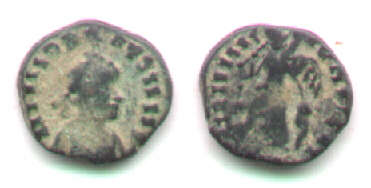 AE12-11. 11:30. 1.31 grams
AE12-11. 11:30. 1.31 grams
Smaller imitation of the same type as above. The obverse has some letter forms suggesting Theodosius, but the reverse letters are all like I's.
Legend of I's:
 AE12. 5:00. 1.11 grams. [This coin is not larger; I am now using large images.]
AE12. 5:00. 1.11 grams. [This coin is not larger; I am now using large images.]
Legend of I's, diademed, draped, cuir. bust right
/type of SALVS REIPVBLICAE, Victory left, dragging captive, nonsense mintmark
Uncertain Emperors
Vota types
This VOT/X/MVLT/XX type was struck for Gratian, Valentinian II, Theodosius, and Arcadius.
imitation: 9 mm. 11:30. 0.42 grams prototype: Theodosius, 13 mm. 1.52 grams. RIC Antioch 56c. mm: ANB
The prototype is small, but the imitation is much smaller.
11-10 mm. 9:00. 0.52 grams
Uncertain ruler with blundered reverse legend: VOT/MVLT/X where "VOT" is not followed by a numeral. The "X" is enough off center that perhaps "XX" was intended but not visible.
10 mm. 11:00. 0.56 grams
Uncertain ruler with blundered reverse legend. VOT/VLT/X. The "T" in "VOT" has large serifs and the "M" of "MVLT" is omitted.
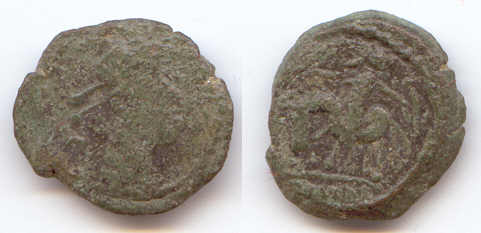 14mm. 9:00.
14mm. 9:00.
Very crude head right, 2 diadem ties clear
/horseman left, horse with large head
imitation of Esty type 42 (with the horse in the other direction), struck for Theodosius, Arcadius, and Honorius:
VICTORIA AVGGG
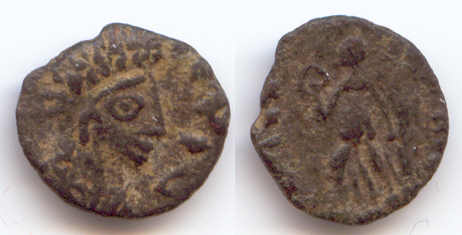 13 mm. 3:00.
13 mm. 3:00.
very crude bust right, illegible attempt at letters. Remarkably bold portrait.
/VICTORIA AVGGG type, with the first two letters clear, Victory left, with wreath
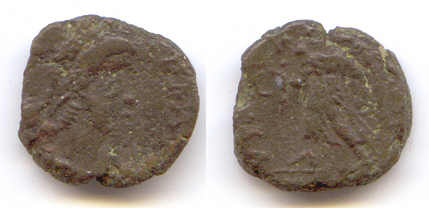 11 mm. 6:00.
11 mm. 6:00.
Weak strike and Victory, only VIC legible
VIRTVS EXERCITI

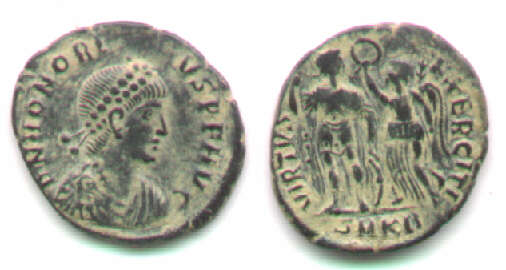
Imitation: Thin AE14. 12:00. 1.17 grams. Official prototype: AE19. 6:00. 2.64 grams.
Small flan and illegible legend,
Possibly Honorius
/VIRTVS EXERCITI, Victory crowns emperor left, who is holdin sceptre in his right
Flan too small for a mintmark.
This prototype example is Esty Type 45: Honorius, Sear 4156. Mintmark SMKB for LRBC 2581, "395-408". RIC X, page 247, Arcadius 68, for Honorius. Struck "395-401."
Similar originals come in slightly smaller sizes, too.
 12 mm. 12:00.
12 mm. 12:00.
crude obverse legend -- Does it read outward? It seems unlikely, but the "C" is backwards.
Victory crowns emperor. Flan much too small for the legend.
Various late Roman types, c. AD 400.
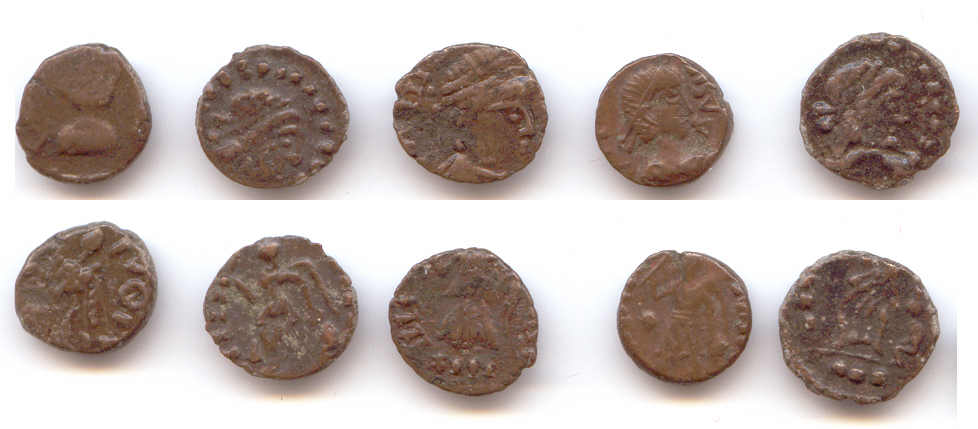
5 pieces, AE8 to AE 10.
Types apparently of SALVS REIPVBLICAE, Victory left, dragging captive
Possibly from the former Yugoslavia.

5 pieces, AE10 to AE11.
Very crude obverses with illegible reverses. From the same group as above, possibly from the former Yugoslavia.
Byzantine AE

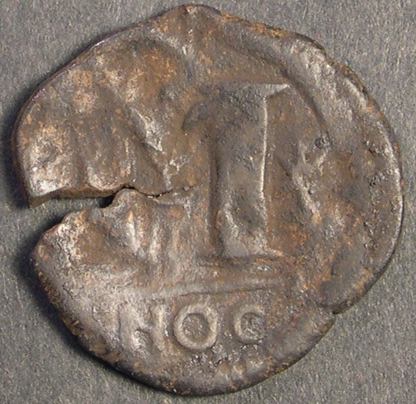
Justin(ian)? AE30. 11:00. 12.06 grams. Full size, but weakly struck and the faln cracked badly.
If Justin, 518-527 AD. If Justinian 527-538 AD (before the bust type switched to facing)
"CON" retrograde in exergue.
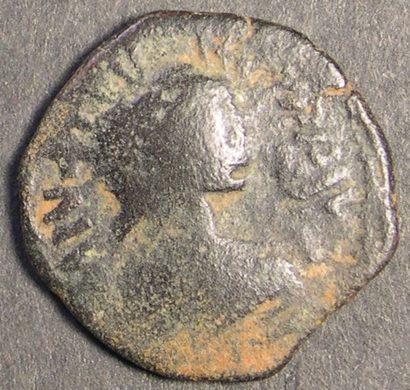
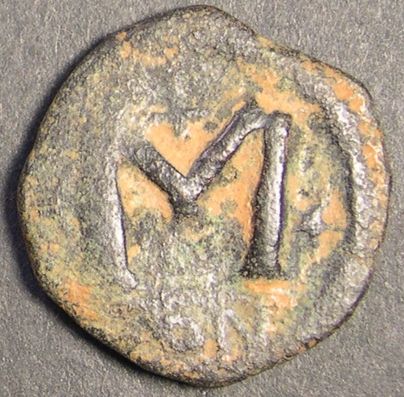
Justin I (518-527 AD). AE30. 6:00. 13.55 grams.
Crude obverse lettering and bust.
Reverse "M" is splayed outward at the top. CON mintmark.
I do not know where these last two were minted or found.
Revised, May 30, 2016
Return to the main page on imitations.